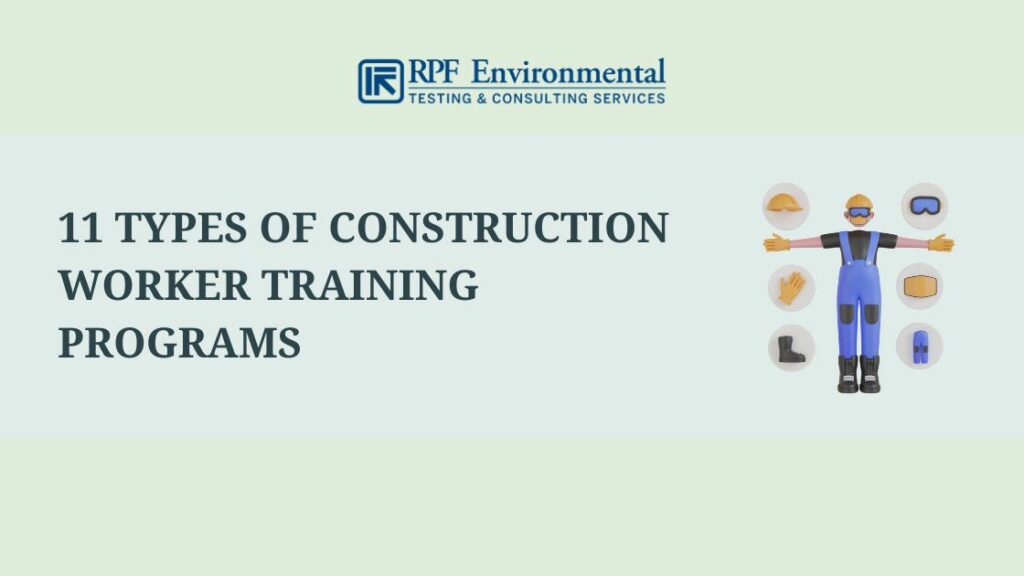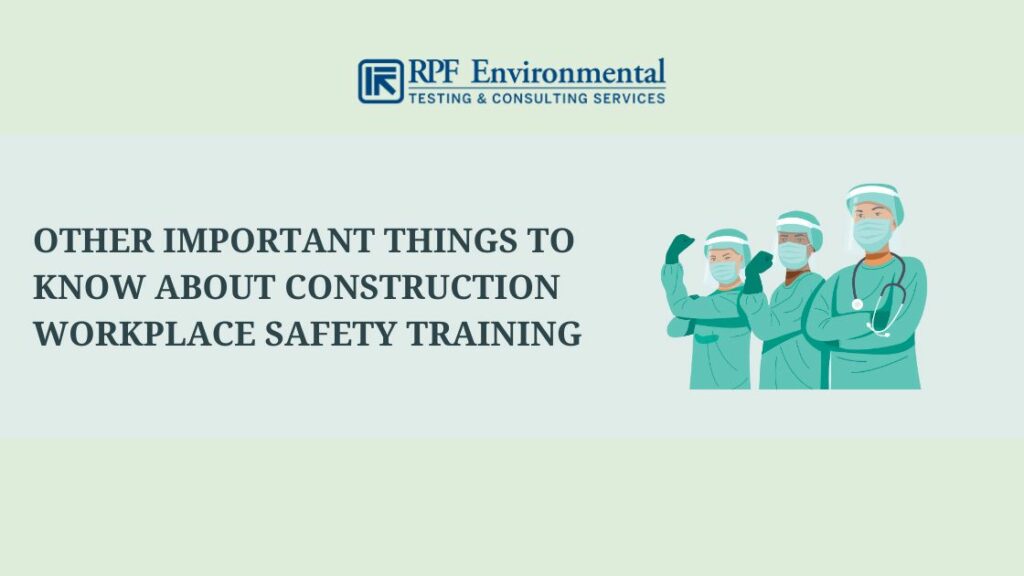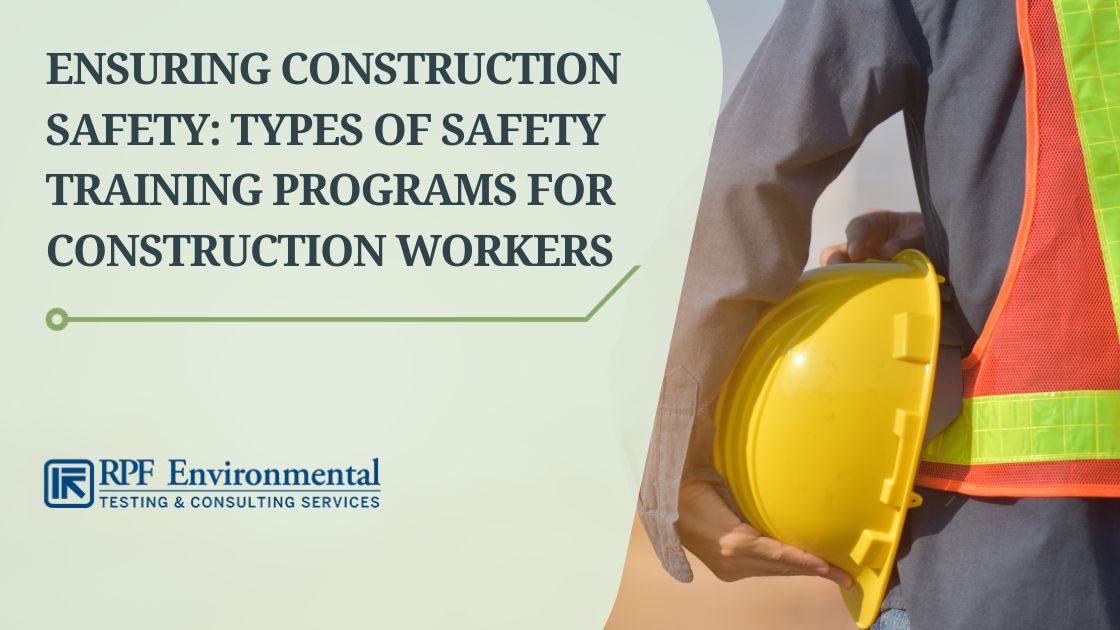The construction industry is a high-risk industry with a lot of hazards. These can cause accidents, injuries, and fatalities especially when inexperienced employees perform dangerous tasks that they are not properly trained in.
OSHA requires employers to provide a safe and healthy working environment for their employees which includes employee training to protect their workers from hazards. However, the type of training (as well as the topics included) will depend on various factors such as the employee’s job duties and nature of work. Thus, we’ve listed the top 11 types of construction safety training programs here along with an overview of the topics included in each training course to guide you.

Let RPF Environmental help you protect your workers from various construction hazards through our EH&S training programs in the New England region. We offer certified construction site safety training along with PPE training among others. Contact us now!
11 Types of Construction Worker Training Programs

Employees who will be exposed to the hazards associated with the tasks involved in the construction safety training programs below must be provided adequate training. A qualified professional must conduct the training in a language and vocabulary that the workers understand. Thus, ensuring that they will be able to work safely without creating additional hazards that might endanger themselves and other people around them.
#1. Excavation, Trenching, & Soil Mechanics
- OSHA Excavation Standard
- Differences between trenches and excavations
- Risks and hazards associated with excavation sites and confined spaces including cave-ins, falling loads, asphyxiation, hazardous atmospheres, drowning, etc.
- How to identify, correct, and avoid hazards
- Shoring types including hydraulic and timber shoring
- Soil mechanics and how it is related to the stability of shored and unshored walls and slopes
- Types of visual and manual testing methods and how to use them to classify soil types (e.g stable rock, type A, type B, type C)
- How rock and soil classification impacts safety
- Required protective systems & equipment including support systems, shield systems, etc.
- Requirements for materials, installation, & removal
- Best practices and techniques in working safely with excavation equipment and navigating around excavations and trenches
- Importance of proper preplanning including safety risk management and using OSHA-compliant safety materials
#2. Fall Prevention & Protection Training
- OSHA Fall Protection Standards
- Types of fall hazards in the workplace including floor holes, wall openings, misused fall protection, slippery surfaces, dangerous machinery, etc.
- How to correctly erect, maintain, disassemble, and inspect fall protection systems that will be used
- Types of fall protection systems such as safety nets, harnesses, stair rails, guardrails, fall arrest systems, warning lines, etc. and how to use and operate them
- Employee roles in fall protection programs and when safety monitoring systems are used
- Mechanical equipment limitations during roofing works on low-sloped roofs
- Materials and equipment handling and storage
- Correct overhead erection procedures
#3. Scaffold Safety Training
- OSHA Scaffolds Standards
- Falling objects hazards, fall hazards, and electrical hazards in the work site
- How to address electrical hazards
- How to properly erect, maintain, and disassemble falling object protection systems and fall protection systems
- Types of scaffolds such as supported and suspended scaffolds
- How to use scaffolds and handle scaffold materials
- Scaffold load-carrying capacities and maximum intended loads
- Load types that can affect scaffolds (e.g. dead loads and live loads)
- Scaffolding access types such as ramps and ladders
- PPE & proper procedures
NOTE: Scaffold safety training should be given to employees involved in inspecting, erecting, disassembling, operating, moving, maintaining, or repairing a scaffold.
#4. Basic Rigging Training
- Rigging fundamentals commonly used in construction
- OSHA regulations for cranes, hoists, and riggings
- Terminologies including working load limit, safe working load, wire rope and slings, etc.
- Pre-lift hazard assessments
- Responsibilities of operators
- Acceptable rigging materials
- Proper equipment inspection, testing, storage, and maintenance
- Types of hoists, cranes, and hitch configurations (e.g. Choke Hitch)
- Best operating practices including safe load limits
- Safe usage of ropes, chains, and slings
- How to select hooks and slings
- Crane and hoist hand signals to properly communicate with crane operators
- How to operate basic rigging equipment
#5. Welding Safety Training
- Welding hazards such as burns, electrical shock, eye damage, noise pollution, and harmful gases and fumes
- Welding fundamentals including types of welding (Shield Metal Arc Welding, Gas Tungsten Arc Welding, Gas Metal Arc Welding, etc.) and safety measures
- Differences between, soldering, welding, and brazing
- Basic safety guidelines
- Fire protection and prevention while welding
- Required personal protective equipment
- Ventilation and confined spaces
#6. Hand & Power Tools Safety Training
- OSHA Hand & Power Tools Standards
- Hand and power tool hazards including abrasions, amputations, punctures, fractures, falling & flying objects, harmful fumes, etc. and how to avoid them
- Types of power tools including power drills, power planers, jig & circular saws, and belt & orbital sanders and their applications
- Safety procedures and precautionary measures when using power tools (e.g. damage inspection, tool selection, proper storage, etc.)
- Identifying inefficiencies and equipment overloading
- Choosing the right type of PPE including breathing apparatus and clothing
#7. Hazard Communication
- OSHA requirements for hazard communication
- Types of chemicals in the workplace that pose hazards and risks (e.g. explosion hazards, corrosive substances) and how to identify them
- Chemical classifications & label systems
- Creating an effective safety program that includes hazardous materials handling, cleaning, and storage
- Harmful effects of chemical exposure
- Safe handling of chemicals to prevent accidents
- Reading and using safety data sheets, GHS hazard labels, and pictograms
- Identifying product labeling
- Adding warning signs and labels
- First-aid and firefighting measures
#8. Personal Protective Equipment (PPE) Training
- OSHA regulations involving PPE (e.g. 29 CFR Part 1926 Subpart E)
- Types of PPEs such as respiratory protection, eye protection, foot protection, face protection, head protection, hearing protection, and hand protection
- Importance of using the right PPE properly to minimize accidents during construction work
- Hearing conservation methods to prevent noise-induced hearing loss
Also Read:
- Effective PPE Selection & Hazard Assessment: 6 Factors to Consider When Choosing Workplace-Specific PPE
- 7 Types of Personal Protective Equipment (PPE) for Construction to Ensure Job Site Safety
#9. Powered Industrial Truck Operator Training
- Powered industrial truck requirements
- Operating instructions, precautions, and warnings for the trucks that the operator can operate
- Differences between trucks and automobiles
- Location, purpose, and usage of truck controls and instrumentation
- Engine/motor operation, steering, and maneuvering
- Visibility and loading restrictions
- Vehicle capacity and stability
- Required vehicle inspection and maintenance
- Attachment and fork use limitations, adaptation, and operation
- Battery refueling and charging/recharging
- Operating limitations, instructions, precautions, warnings, etc. in the truck’s operator’s manual
- Workplace conditions, pedestrian traffic, and restricted places where the truck will be operated including sloped surfaces that can impact vehicle stability
- Load composition, stability, manipulation, stacking, & unstacking
Also Read: 12 Heavy Construction Equipment Safety Tips & Important Safety Precautions to Prevent Workplace Hazards
#10. Steel Erection Training
- Controlled Decking Zone (CDZ) training
- Identification of fall hazards
- The operation and use of different types of protection including guardrail systems, personal fall arrest systems, safety net systems, fall restraint systems, and positioning device systems
- Erecting, disassembling, inspecting, and maintaining fall protection systems properly
- Safety procedures to prevent all types of falls
- Other fall protection requirements in 29 CFR Part 1926 Subpart R (Steel Protection)
NOTE: Special training should be provided to employees involved in multiple lift rigging, connector procedures, and Controlled Decking Zone Procedures.
#11. Stairway & Ladder Safety Training
- OSHA Stairways and Ladders Standards
- Hazards in the work area
- Erecting, maintaining, & disassembling fall protection systems
- Proper use, construction, care, and placement when handling ladders and stairways
- Maximum ladder load-carrying capacities
Other Types of Construction Occupational Safety and Health Training Courses
Other safety training courses in the construction industry include the following:
- Hazardous Materials
- Asbestos in Construction
- Lead Safety
- Fire protection
- Materials handling and storage
- Machine guarding
- Electrical safety
- Hazard communication
- Hazardous Waste Operations
- Confined Space Entry
- Lockout/Tagout
Other Important Things to Know About Construction Workplace Safety Training

Why Is Construction Safety Training Important?
The construction industry has the second most occupational deaths in 2021 with falls, struck-by incidents, caught-in or between accidents, and electrocutions being the top causes of deaths. This makes health and safety training for construction workers crucial in keeping employees well-equipped with the right skills and knowledge required to perform their tasks safely.
Specific benefits of construction training include:
- Compliance with regulatory requirements to avoid costly violations, fines, and penalties
- Well-equipped employees who can work safely to prevent accidents
- Reduced absenteeism and worker compensation claims
Also Read: Importance of Safety Training in Construction: How Health & Safety Training Can Benefit the Construction Industry
Integrating Construction Safety Training in Your Safety & Health Program to Reduce Workplace Incidents
Employee training is a crucial part of comprehensive and integrated safety and health programs, not only for compliance purposes but also to reduce indirect costs and prevent reputational damage.
OSHA has recommended practices for safety and health programs in construction that include the following core elements:
- Management leadership
- Worker participation
- Hazard identification & assessment
- Hazard prevention & control
- Education & training
- Program evaluation & improvement
- Communication and coordination for employers on multiemployer worksites
All workers should be trained to understand how the safety program works and how to perform their responsibilities as specified in the program. They should also be able to recognize workplace hazards and implement proper control measures. In addition to workers, employers, supervisors, and managers should also be trained especially on their responsibilities for protecting the workers’ rights.
FAQs
Employee safety training programs are designed to provide employees with the right skills and knowledge that will allow them to perform their duties without putting themselves and other people at risk.
The best construction safety course will depend on various factors such as the employee’s job duties, workplace conditions, types of hazards, and others. It is usually site-specific to ensure that workers will receive the type of training they really need.
The construction industry is among the top industries that has the most occupational deaths and most OSHA construction violations involve the construction industry. To prevent these from happening, employee training must be provided.
Providing adequate training to employees is one of the most important construction site safety rules including the selection and proper usage of the right Personal Protective Equipment. Others include using the right tools and equipment, keeping the site clean, following OSHA guidelines, and more.
Conclusion
The construction industry might be using the latest technological innovations to improve workplace safety, but this cannot guarantee the elimination of workplace hazards that can endanger employees. With the right construction safety training, workers will know how to detect hazards and avoid them before they can lead to accidents.
RPF Environmental can help you maximize safety through our certified health and safety training for construction workers to help you protect your assets and business. We serve areas in Maine, Massachusetts, New Hampshire, and beyond the United States. Contact us now!




